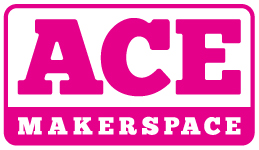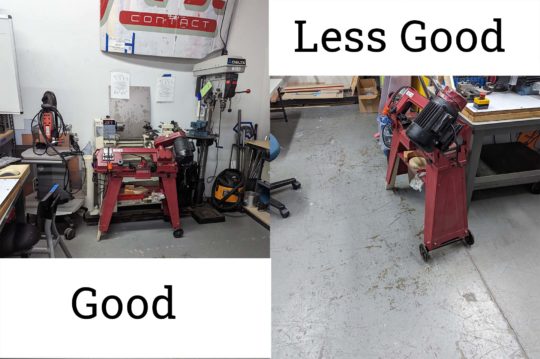 Loading asset information.
Loading asset information.
Manual: Horizontal_Bandsaw_Instruction_Manual
Do NOT adjust this machine unless you have read the instruction manual and are confident with what you are doing.
Important: Do NOT overtighten the blade
There is a real knob for the blade tension adjustment. When adjusting blade tension, the goal is for it to be as loose as possible without slipping. Don’t overtighten it. Doing this will only cause more wear and tear. If the blade is slipping give the knob a little twist. If it isn’t slipping try loosening it a bit.
Selecting the correct blade for your material
Blades have different numbers of teeth per inch (TPI). Pick the smallest number of TPI that will allow at least 3 teeth to be in the material you are cutting at a time. For example, when cutting something 1″ thick, you would want a blade with 3-4 TPI. If you are cutting something 1/4″ thick, use a blade with at least 12 TPI.
It is a common mistake to use a blade with too many TPI (lots of little teeth). This will result in slower cutting, and more wear and tear on the blades because the teeth clog up with the material and don’t cut very well. Please, read the instruction manual to learn how to change blades!
There are usually several blades available in the shop. They usually live bottom drawer of the plastic rolling cart. If you need something else discuss it on the #heavy-metal channel or purchase the blade you need. The blades for this machine are 64-1/2” L x 15/32” or 1/2″ W x 0.025” Thick.
If you break a blade, don’t throw it away. We can sometimes solder them back together. Please mention it on the #heavy-metal channel to see if that is an option before throwing it away.
Proper ”Break-In Procedures” for any new blades
Following proper break-in procedures greatly extends the life of new blades. Not doing so can reduce blade life by up to 60%. 1 Ideally, you can find the procedures provided by the blade’s manufacturer or vendor. If not, a general-purpose procedure is as follows:
- When cutting softer material like aluminum, mild steel, or fully annealed steel during the break-in period reduce feed and/or speed to 1/3 to 1/2 of normal for the first 100 square inches of material, then slowly bring the feed pressure to normal. Watch the chip formation. If you see powdery waste more than chips, increase pressure lightly – just enough to establish fine, curly, warm chips. If the chips are heavy and/or excessively hot, blued, etc., reduce the feed pressure. The same goes for post-breaking cutting: heat is the enemy.
- Harder materials or materials prone to work hardening should be cut at 3/4 the normal rate for the first 25 square inches of material is cut. At this point, slowly increase the feed pressure so that it reaches a normal rate around the time 50 square inches have been cut.
- Note that softer materials require ”longer” break-in periods and ”slower ”initial feed pressures. However, ”once the break-in period is passed, ” softer materials require ”faster” blade” ”speeds in order clear the chips.
How to adjust the cutting speed
The saw speed is measured in surface feet per minute, or SFM. Adjust the speed of the saw blade by moving the belt (inside the sheet metal cover at the motor end of the machine) onto the different sized pairs of pulleys. Putting the belt on the innermost pulleys (small on the motor end, largest on the blade end), the blade goes slower (80 SFM surface feet per minute). On the middle set of pulleys, you get 120 SFM. On the outermost (large on the motor end, small on the blade end) you get the fastest speed of 200 SFM.
Harder materials generally need slower speeds. A guideline is:
- 200 SFM for aluminum and other soft materials
- 120 SFM for softer grades of steel
- 80 SFM for harder steels, stainless, and cast iron.
Please Note: the blade tracking/drive wheel alignment has been adjusted. This is adjusted by the hex nuts on the side of the saw on the opposite end from the motor. Some people seem to think these are for blade tension and mess with them. They are not. Please do not adjust these unless you read the instruction book and know what you are doing. If the blade is coming off the wheels regularly, read the manual and learn how to adjust it.
Storage when not in use
When not in use or moved for other tool use the saw should be stored in front of the lathe.
Logs
 Loading asset logs.
Loading asset logs.

